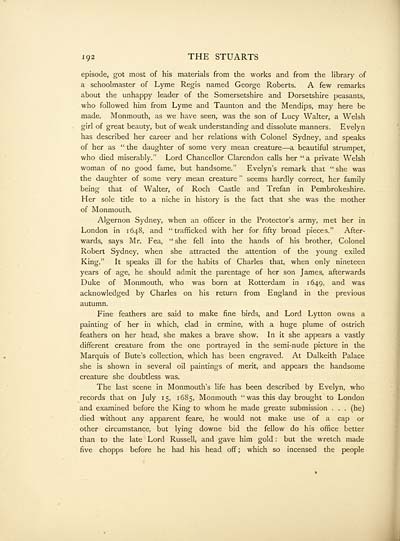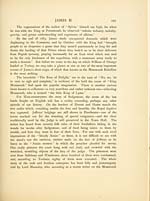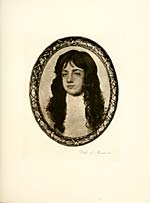Stuarts
(250) Page 192
Thumbnail gallery: Grid view | List view

192 THE STUARTS
episode, got most of his materials from the works and from the library of
a schoolmaster of Lyme Regis named George Roberts. A few remarks
about the unhappy leader of the Somersetshire and Dorsetshire peasants,
who followed him from Lyme and Taunton and the Mendips, may here be
made. Monmouth, as we have seen, was the son of Lucy Walter, a Welsh
girl of great beauty, but of weak understanding and dissolute manners. Evelyn
has described her career and her relations with Colonel Sydney, and speaks
of her as " the daughter of some very mean creature — a beautiful strumpet,
who died miserably." Lord Chancellor Clarendon calls her "a private Welsh
woman of no good fame, but handsome." Evelyn's remark that "she was
the daughter of some very mean creature " seems hardly correct, her family
being that of Walter, of Roch Castle and Trefan in Pembrokeshire.
Her sole title to a niche in history is the fact that she was the mother
of Monmouth.
Algernon Sydney, when an officer in the Protector's army, met her in
London in 1648, and "trafficked with her for fifty broad pieces." After-
wards, says Mr. Fea, " she fell into the hands of his brother, Colonel
Robert Sydney, when she attracted the attention of the young exiled
King." It speaks ill for the habits of Charles that, when only nineteen
years of age, he should admit the parentage of her son James, afterwards
Duke of Monmouth, who was born at Rotterdam in 1649, and was
acknowledged by Charles on his return from England in the previous
autumn.
Fine feathers are said to make fine birds, and Lord Lytton owns a
painting of her in which, clad in ermine, with a huge plume of ostrich
feathers on her head, she makes a brave show. In it she appears a vastly
different creature from the one portrayed in the semi-nude picture in the
Marquis of Bute's collection, which has been engraved. At Dalkeith Palace
she is shown in several oil paintings of merit, and appears the handsome
creature she doubtless was.
The last scene in Monmouth's life has been described by Evelyn, who
records that on July 15, 1685, Monmouth "was this day brought to London
and examined before the King to whom he made greate submission . . . (he)
died without any apparent feare, he would not make use of a cap or
other circumstance, but lying downe bid the fellow do his office better
than to the late Lord Russell, and gave him gold : but the wretch made
five chopps before he had his head off; which so incensed the people
episode, got most of his materials from the works and from the library of
a schoolmaster of Lyme Regis named George Roberts. A few remarks
about the unhappy leader of the Somersetshire and Dorsetshire peasants,
who followed him from Lyme and Taunton and the Mendips, may here be
made. Monmouth, as we have seen, was the son of Lucy Walter, a Welsh
girl of great beauty, but of weak understanding and dissolute manners. Evelyn
has described her career and her relations with Colonel Sydney, and speaks
of her as " the daughter of some very mean creature — a beautiful strumpet,
who died miserably." Lord Chancellor Clarendon calls her "a private Welsh
woman of no good fame, but handsome." Evelyn's remark that "she was
the daughter of some very mean creature " seems hardly correct, her family
being that of Walter, of Roch Castle and Trefan in Pembrokeshire.
Her sole title to a niche in history is the fact that she was the mother
of Monmouth.
Algernon Sydney, when an officer in the Protector's army, met her in
London in 1648, and "trafficked with her for fifty broad pieces." After-
wards, says Mr. Fea, " she fell into the hands of his brother, Colonel
Robert Sydney, when she attracted the attention of the young exiled
King." It speaks ill for the habits of Charles that, when only nineteen
years of age, he should admit the parentage of her son James, afterwards
Duke of Monmouth, who was born at Rotterdam in 1649, and was
acknowledged by Charles on his return from England in the previous
autumn.
Fine feathers are said to make fine birds, and Lord Lytton owns a
painting of her in which, clad in ermine, with a huge plume of ostrich
feathers on her head, she makes a brave show. In it she appears a vastly
different creature from the one portrayed in the semi-nude picture in the
Marquis of Bute's collection, which has been engraved. At Dalkeith Palace
she is shown in several oil paintings of merit, and appears the handsome
creature she doubtless was.
The last scene in Monmouth's life has been described by Evelyn, who
records that on July 15, 1685, Monmouth "was this day brought to London
and examined before the King to whom he made greate submission . . . (he)
died without any apparent feare, he would not make use of a cap or
other circumstance, but lying downe bid the fellow do his office better
than to the late Lord Russell, and gave him gold : but the wretch made
five chopps before he had his head off; which so incensed the people
Set display mode to:
![]() Universal Viewer |
Universal Viewer | ![]() Mirador |
Large image | Transcription
Mirador |
Large image | Transcription
Images and transcriptions on this page, including medium image downloads, may be used under the Creative Commons Attribution 4.0 International Licence unless otherwise stated. ![]()
| Histories of Scottish families > Stuarts > (250) Page 192 |
|---|
| Permanent URL | https://digital.nls.uk/95242051 |
|---|
| Description | A selection of almost 400 printed items relating to the history of Scottish families, mostly dating from the 19th and early 20th centuries. Includes memoirs, genealogies and clan histories, with a few produced by emigrant families. The earliest family history goes back to AD 916. |
|---|

